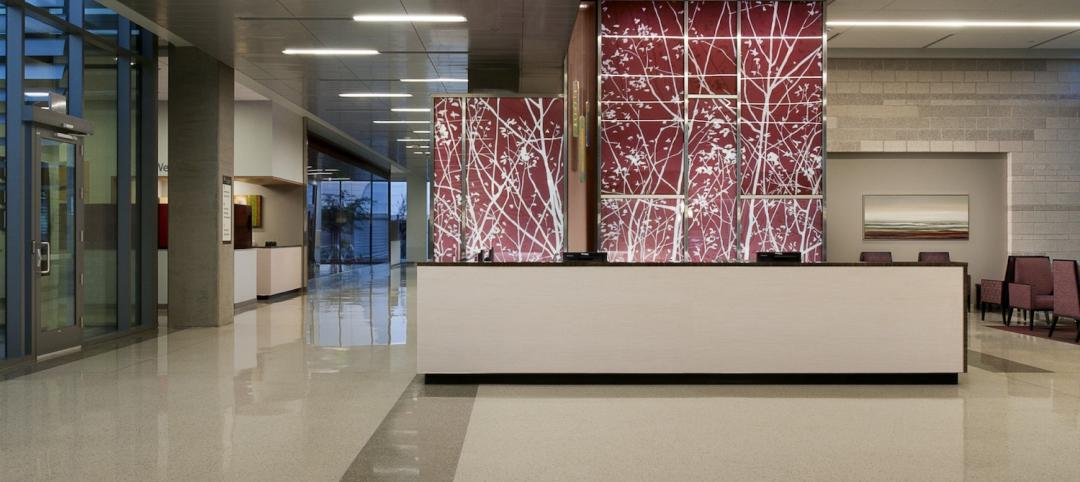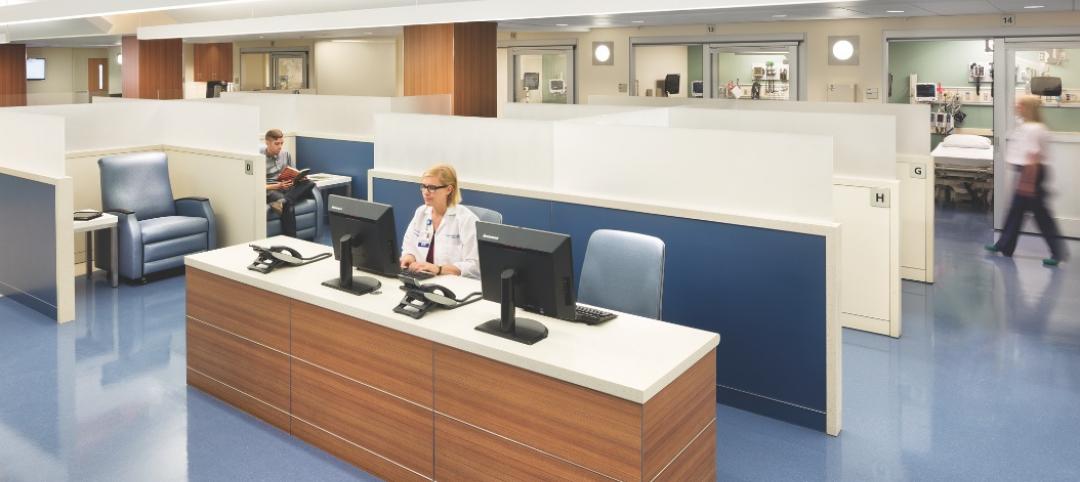About four years ago, executives at MaineGeneral Health, which has served the people of the Kennebec Valley since 1891, realized that they faced a classic decision: Should they renovate their two primary facilities, one in Augusta, the state capital, the other 20 or so miles north in Waterville, or start all over?
“Just to keep up those two facilities would have cost $100 million, and it would have been another patchwork renovation that could not give us the quality we needed,” recalled MaineGeneral President/CEO Chuck Hays. “To set us up for the future, a new site was the way to go.”
Having successfully built a new cancer center in 2007 under a collaborative project model, Hays, an engineer, and his team set out to build a new hospital at a central location in Augusta, using integrated project delivery. To implement their vision, they asked the Building Team of contractors Robins & Morton and H.P. Cummings Construction and design firms SMRT and TRO JB to enter into an IPD agreement that would guarantee fixed costs and completion imperatives, quality of patient care through evidence-based design (EBD), and operational efficiencies via sustainable design and Lean principles.
GOLD AWARD
Project SummaryAlfond Center for Health
Augusta, MaineBUILDING TEAM
Submitting firm: Robins & Morton (GC), joint venture with H.P. Cummings Construction
Owner: MaineGeneral Medical Center
Architect, interior architect, MEP engineer: SMRT and TRO JB
Structural engineer: SMRTGENERAL INFORMATION
Project size: 644,000 sf
Construction cost: $312,000,000
Construction period: August 2011 to August 2013
Delivery method: Integrated project delivery
It became immediately apparent that the chief stumbling block to the IPD agreement was the insurance. In the words of John Milbrand, PE, Construction Manager for MaineGeneral, “Insurance companies don’t know how to act when the parties agree not to blame each other.” After weeks of negotiation, MaineGeneral put together an owner-controlled insurance policy to cover worker’s compensation and other liabilities.
In early 2011, with the IPD firmly in place, the team began engaging 250 MaineGeneral staff, plus community members, patients, and patient advocates, in design discussions. They toured new hospitals across the country to gather ideas.
Before any work could get started, however, MaineGeneral’s financing was held up, and the Building Team faced the prospect of losing months of warm-weather construction time. Under a typical design-bid-build contract, no work would have been allowed to proceed; but with the IPD, the site work subcontractor was able to start moving dirt without waiting for change orders.
Then, in August 2011, just as crews were starting to roll, Hurricane Irene deluged the site, threatening the protected streams on the property with damage from runoff. The Building Team worked with the state Department of Environmental Protection to pump runoff from containment ponds into tanker trucks and transport it to a DEP-approved disposal area, thereby saving the streams from excess turbidity.
The Building Team’s entrepreneurial creativity, spurred by the IPD and inspired by a forward-thinking client, went well beyond the norm.

As a key component of evidence-based design, all 192 patient rooms are private to reduce hospital-induced infection. Each room has a family area with a sofa bed and a table that pops up for sharing meals, a patient lift, and a handrail between the bed and the bathroom to prevent falls. PHOTO: ANTON GRASSL/ESTO
For example, when the team put out RFPs for drywall/acoustical ceiling work, it became clear that the four local subcontractors would be bidding against each other on the biggest such job in the state. This put MaineGeneral’s management in an awkward position.
Instead of awarding the job to a single subcontractor, the hospital invited the four companies to operate under a single contract for the drywall work. This had never been done before, and it posed grave financial risk to the companies—not to mention to the hospital—but they made it work. In fact, of $172 million in subcontracts on the hospital, $167 million (97%) went to firms based in Maine, and 90% of the 3,000 jobs created by the project went to state residents.
To gain time and be as lean as possible, the Building Team set up an assembly line in an onsite basement, where they produced headwalls and bathrooms for the patient rooms. This shaved 25% off the delivery time for installing these components versus stick-built construction. Exterior wall panels were prefabbed and shipped in from a warehouse factory 60 miles from Augusta, in Portland, which allowed the building envelope to be closed in early, saving the owner thousands of dollars in temporary heating costs.
Construction of the Alfond Center for Health was completed in 24 months, nine months ahead of schedule, at a price below the validated target cost. Some of the savings went back into the project in the form of value-added improvements, including a 4,000-sf facilities building and a redundant data center.

Daylight floods the reception area at the 644,000-sf replacement hospital. It was originally programmed to attain LEED Silver certification, but the Building Team was able to earn it LEED Gold status. Environmental components include a 140,000-sf reflective roof, outdoor healing gardens, rainwater collection, and a heat-recovery system. The Building Team used mockups to test the functionality of patient rooms and exterior façades. PHOTO: ANTON GRASSL/ESTO
At 192 beds—all single-occupancy, a key element of EBD—the $312 million facility surpassed its planned LEED Silver certification to achieve LEED Gold. Sustainable elements include a heat-recovery system, rainwater collection and reuse, ice production to offset peak electrical use, LED lighting, a 140,000-sf white roof, and the use of natural gas instead of fuel oil for heating. Paul Stein, MaineGeneral’s COO, calculates that these initiatives will cut the hospital’s utility bills in half, to $3.27/sf, compared to $7.80/sf at the facilities it replaced.
Building Team Awards jurors appreciated the team’s attention to detail. “The patient rooms were well thought out,” said judge Terry Fielden, LEED AP BD+C, Director of K-12 Education at International Contractors, Inc. Prototype rooms were mocked up so that patients, their families, and hospital staff could make suggestions. Rooms were laid out with a handrail between the head of the bed and the nearby entrance to the bathroom. “You can see the evidence-based design in the patient rooms,” said judge Susan Heinking, AIA, NCARB, LEED AP O+M, VP and Sustainability Leader at VOA Associates.
Related Stories
| Nov 3, 2014
IIT names winners of inaugural Mies Crown Hall Americas Prize
Herzog & de Meuron's iconic 1111 Lincoln Road parking garage in Miami Beach, Fla., is one of two winners of the $50,000 architectural prize.
| Nov 3, 2014
Cairo's ultra-green mixed-use development will be topped with flowing solar canopy
The solar canopy will shade green rooftop terraces and sky villas atop the nine-story structure.
| Nov 2, 2014
Top 10 LEED lessons learned from a green building veteran
M+W Group's David Gibney offers his top lessons learned from coordinating dozens of large LEED projects during the past 13 years.
| Oct 31, 2014
Dubai plans world’s next tallest towers
Emaar Properties has unveiled plans for a new project containing two towers that will top the charts in height, making them the world’s tallest towers once completed.
| Oct 30, 2014
CannonDesign releases guide for specifying flooring in healthcare settings
The new report, "Flooring Applications in Healthcare Settings," compares and contrasts different flooring types in the context of parameters such as health and safety impact, design and operational issues, environmental considerations, economics, and product options.
| Oct 30, 2014
Perkins Eastman and Lee, Burkhart, Liu to merge practices
The merger will significantly build upon the established practices—particularly healthcare—of both firms and diversify their combined expertise, particularly on the West Coast.
| Oct 29, 2014
Better guidance for appraising green buildings is steadily emerging
The Appraisal Foundation is striving to improve appraisers’ understanding of green valuation.
| Oct 29, 2014
Increasing number of design projects meeting carbon reduction targets, says AIA report
Of the 2,464 projects accounted for in AIA's 2030 Commitment 2013 Progress Report, 401 are meeting the 60% carbon reduction target—a 200% increase from 2012.
Sponsored | | Oct 29, 2014
What’s the difference between your building’s coating chalking and fading?
While the reasons for chalk and fade are different, both occurrences are something to watch for. SPONSORED CONTENT
Sponsored | | Oct 29, 2014
Historic Washington elementary school incorporates modular design
More and more architects and designers are leveraging modern modular building techniques for expansion projects planned on historical sites. SPONSORED CONTENT














